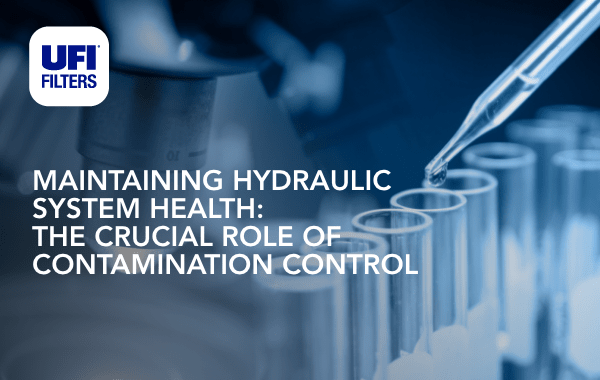
Contamination control in hydraulic systems is a critical aspect of maintaining the health of the system that directly influences the efficiency, reliability, and lifespan of hydraulic circuits.
At UFI Filters Hydraulics, we understand the complexity of contamination control and aim to provide a brief overview to emphasize its significance.
The Fluid’s Role in the Hydraulic System
The primary function of the fluid in a hydraulic system is to transmit power and motion.
In addition, it performs an important function in lubricating the system.
Selecting the right fluid is crucial for the reliable and efficient operation of the system, taking into account the specific working conditions of the machine, such as the working pressure, the temperature, and the environment in which it operates.
Hydraulic fluids, including mineral oils, synthetic fluids, water-based fluids, and environmentally friendly options, are classified according to international standards.
However, maintaining fluid cleanliness is essential to prevent fluid ageing as well as any malfunctions and failures within the hydraulic system.
Solid Contaminants
Solid contaminants stand out as the primary causes of hydraulic system issues.
While completely eliminating contaminants is impossible, keeping contamination under control is achievable through the use of proper devices, such as filters.
Regardless of the hydraulic fluid chosen, it is essential to maintain contamination at the level specified by the manufacturer of the most sensitive component in the system.
Contamination Control
Contamination control in hydraulic systems must be given due consideration.
In fact, industry studies show that up to 80% of hydraulic system failures are caused by contamination.
These failures can take many forms, including:
- Increased friction and wear: contaminant particles act as abrasives, causing increased wear on pistons, valves, and other moving components. This wear reduces component lifespans and generates additional debris, exacerbating the problem.
- Reduced efficiency: contamination causes wear and tear on components, resulting in leakage and therefore efficiency losses, which can lead to reduced productivity and increased energy consumption.
- Early system failure: severe contamination can lead to premature wear and the breakdown of critical components, resulting in downtime and costly repairs.
Measuring Contamination: The ISO 4406 Standard
To effectively manage contamination levels, it is essential to quantify the numbers and sizes of the particles in the hydraulic fluid.
This is usually achieved through the use of automatic particle counters (APCs), which measure the number of particles per unit volume of fluid.
This count is then used to determine the contamination class based on international standards.
One of the most commonly used standards is ISO 4406, which defines three levels that characterize the particle size distribution. The ISO cleanliness code comprises three values, representing the number of particles per millimetre of fluid with sizes equal to or exceeding 4 µm, 6 µm, and 14 µm, respectively.
For instance, the ISO cleanliness code 21/18/15 defines a fluid as follows:
- Code 21: this value indicates that the fluid contains less than 20,000 and more than 10,000 particles of ≥4 µm(c) per 1 ml.
- Code 18: this value indicates that the fluid contains less than 2,500 and more than 1,300 particles of ≥6 µm(c) per 1 ml.
- Code 15: this value indicates that the fluid contains less than 320 and more than 160 particles of ≥14 µm(c) per 1 ml.
Achieving and Maintaining Contamination Control
To achieve and maintain optimal contamination control in hydraulic systems, a comprehensive approach is essential.
This includes:
- Regular fluid analysis: regularly monitor the contamination level of the hydraulic fluid using APCs. This will help identify potential contamination sources and ensure that the system is maintained at the required cleanliness level as defined by the manufacturer-specified cleanliness code.
- Strategic filtration: install a multi-stage filtration system that removes particles of various sizes, depending on the position of the component in the system (suction, return, pressure) and the level of fluid cleanliness required.
- Preventive maintenance: perform regular maintenance to prevent contamination from entering the system, checking for leaks, replacing seals, O-rings and worn components, and inspecting hydraulic components for damage.
- Correct maintenance practices: implement proper working practices to minimize contamination during fluid handling, system filling, and component replacement.
Conclusions
Contamination control is an ongoing process that requires continuous monitoring, maintenance, and vigilance.
By adopting the strategies outlined above, hydraulic system operators can safeguard their systems from the effects of contamination and guarantee the long-term efficiency, reliability, and cost-effectiveness of their operations.
UFI Filters Hydraulics is committed to providing its customers with high-quality, customized filtration solutions to achieve optimum levels of contamination control.
Our team of experts can help you select the most suitable filters and accessories for your specific application, to help you ensure that your hydraulic system keeps operating at peak performance.
For more in-depth technical information, contact our sales team now!